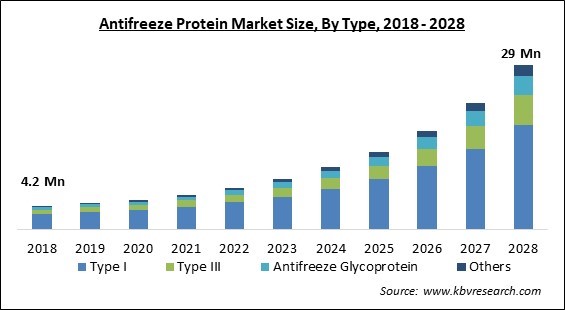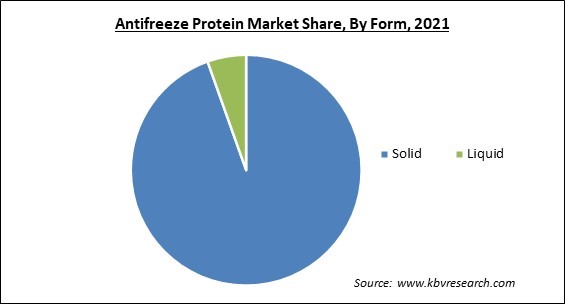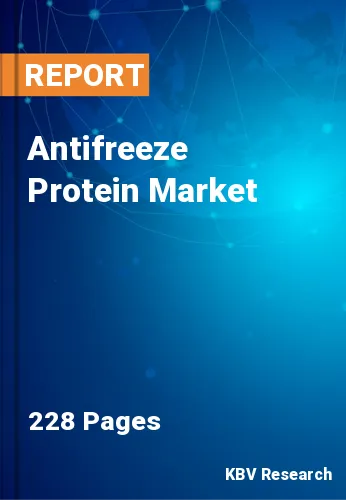The Global Antifreeze Protein Market size is expected to reach $29 million by 2028, rising at a market growth of 25.7% CAGR during the forecast period.
Antifreeze proteins (AFPs) are biological antifreezes with distinct characteristics such as thermal hysteresis (TH), ice re-crystallization inhibition (IRI), and contact with membranes and/or membrane proteins. These characteristics have been used to keep biological samples safe at low temperatures.

The market is being augmented by increased investments from some aquaculture firms in order to buy frozen products. The firms are concentrating on the premium taste of smoked fish combined with the ideal texture. Consumer demand for aurora salmon in many regions is rapidly increasing, moving the business forward. In addition, important firms are concentrating on launching low-cost organic salmon food products. As a result, the market is predicted to increase significantly over the forecast period.
Improved aquaculture practices in cold regions, refined freeze tolerance growth of plants, extended harvest season in cold climates, and improved cryosurgery procedures will all boost industry sales. In addition, the increasing use of antifreeze proteins in yogurts and ice creams is expected to boost the need for antifreeze protein. High investments by key firms in the food industry to develop new frozen goods are likely to enhance industry sales even more. The antifreeze protein market would benefit from the rising applications of antifreeze proteins in the pharmaceutical industry, as well as increased R&D efforts. Antifreeze protein is used to increase the bio-availability of medications due to different bio-active effects such as antibacterial action and physiological benefits that can underpin overall human health, in addition to dietary uses.
Moreover, Antifreeze proteins (AFPs) or ice structuring proteins (ISPs) are polypeptides that enable plants, animals, fungi, and bacteria to live in temperatures below freezing. AFPs bind to little ice crystals, preventing them from growing and recrystallizing, which would be devastating otherwise. AFPs may potentially interact with mammalian cell membranes to protect them from cold damage. This is revealed that AFPs are involved in cold acclimation.
The COVID-19 pandemic's expansion has far-reaching consequences for the fruit and vegetable industry. There were attempts made to ensure supply consistency and continuity at points of sale; nonetheless, new costs and hurdles had to be overcome. These new costs were incurred as a result of variables such as social distancing measures causing inefficiencies in the orchard and pack house operations, increased logistical costs owing to trucks returning empty to their bases, and additional safety procedures and delays. Market pressures and product losses were also factors. As a result, there is a growing demand for effective storage methods at key trade ports and markets to protect the safety of fruits and vegetables while also ensuring a steady supply to retail markets.
Antifreeze proteins prevent ice crystal development caused by freezing, which decreases texture quality significantly. These antifreeze proteins can be added to fish, yeast, vegetables, and fruits using trans-genesis procedures and protocols to offer these organisms new useful qualities. Along with that, the applications offer certified advantages that result in high-quality food production and distribution. As a response, the market demand is growing. One of the main advantages of antifreeze proteins is that it keeps the biological samples safe from any risk of pilferage.
In emerging countries, rising living standards and changing lifestyles contribute to increased demand for ready meals, cosmetics, and immunizations, all of which have an indirect impact on the market. Emerging markets are likely to provide considerable market growth potential for the key market players. AFPs work by lowering the freezing point of water and preventing the formation of ice crystals in the frozen state. The medical associations of various developing regions are investing a tremendous amount of money into creating and implementing innovations like antifreeze proteins.
Antifreeze proteins have a restricted number of commercial applications in the food business, which limits the antifreeze proteins market's potential. Cosmetics, healthcare, and frozen foods industries, on the other hand, use them. The majority of companies are still in the research and development phase when it comes to finding new uses for antifreeze proteins in the food industry. With the limited application of antifreeze proteins in the food business, the market is having limited prospects to grow. Even though, the research and development team is working on finding new applications to grow the market.
Based on Type, the market is segmented into Type I, Type III, Antifreeze Glycoprotein, and Others. The Type III segment garnered a significant revenue share in the antifreeze protein market in 2021. This is because of its increasing use in the pharmaceutical industry. Type III antifreeze proteins have superior cryo-preservation than any other antifreeze protein. Various medical firms and hospital units are seeking for proper type III outlook.

Based on Form, the market is segmented into Solid and Liquid. The solid segment witnessed the maximum revenue share in the antifreeze protein market in 2021. This is due to the convenience of availability in solid form from the source of origin. Frozen foods, ice cream goods, frozen seafood, and meats are all examples of where they're used. In addition, the solid form has a longer shelf life than the liquid version, making it more suitable for usage in frozen foods.
Based on Source, the market is segmented into Fish and Others. The other segment procured a substantial revenue share in the antifreeze protein market in 2021. Fungi, bacteria, plants, and insects are all included in this category. This is because of the extreme earthly winter temperatures, the insect source has more effective proteins than the fish source. As a result, the others segment is likely to increase significantly.
Based on End-use, the market is segmented into Medical, Food, Cosmetics, and Others. The medical segment acquired the highest revenue share in the antifreeze protein market in 2021. This is due to increased research and development from biotechnology and pharmaceutical businesses, as well as ongoing research on COVID-19 vaccines. The healthcare units are showing enhanced interest in the inclusion of antifreeze protein elements.
| Report Attribute | Details |
|---|---|
| Market size value in 2021 | USD 6.2 Million |
| Market size forecast in 2028 | USD 29 Million |
| Base Year | 2021 |
| Historical Period | 2018 to 2020 |
| Forecast Period | 2022 to 2028 |
| Revenue Growth Rate | CAGR of 25.7% from 2022 to 2028 |
| Number of Pages | 228 |
| Number of Tables | 439 |
| Report coverage | Market Trends, Revenue Estimation and Forecast, Segmentation Analysis, Regional and Country Breakdown, Companies Strategic Developments, Company Profiling |
| Segments covered | Type, Form, Source, End-use, Region |
| Country scope | US, Canada, Mexico, Germany, UK, France, Russia, Spain, Italy, China, Japan, India, South Korea, Singapore, Malaysia, Brazil, Argentina, UAE, Saudi Arabia, South Africa, Nigeria |
| Growth Drivers |
|
| Restraints |
|
Based on Regions, the market is segmented into North America, Europe, Asia Pacific, and Latin America, Middle East & Africa. Asia Pacific emerged as the leading region in the antifreeze protein market with the largest revenue share in 2021. This can be attributed to the fact that the majority of marine capture and aquaculture production occurs in the region. Antifreeze proteins are in high demand in the pharmaceutical and cosmetics industries. This is because antifreeze proteins are widely used in vaccine manufacturing, and the existence of world-leading vaccine makers in this region is boosting the market growth.
Free Valuable Insights: Global Antifreeze Protein Market size to reach USD 29 Million by 2028
The market research report covers the analysis of key stake holders of the market. Key companies profiled in the report include Kaneka Corporation, Unilever PLC, Nichirei Corporation, A/F Protein Canada Inc., Sirona Biochem, Protokinetix, Inc., Shanghai Yu Tao Industrial Co., Ltd., Kodera herb garden co., ltd., Rishon Biochem Co., Ltd., and Mybiosource, Inc.
By Type
By Form
By Source
By End Use
By Geography
The global antifreeze protein market size is expected to reach $29 million by 2028.
Growing markets in developing regions are driving the market in coming years, however, Food applications are limited and it restraint the growth of the market.
Kaneka Corporation, Unilever PLC, Nichirei Corporation, A/F Protein Canada Inc., Sirona Biochem, Protokinetix, Inc., Shanghai Yu Tao Industrial Co., Ltd., Kodera herb garden co., ltd., Rishon Biochem Co., Ltd., and Mybiosource, Inc.
The expected CAGR of the antifreeze protein market is 25.7% from 2022 to 2028.
The Fish segment acquired maximum revenue share in the Global Antifreeze Protein Market by Source 2021, thereby, achieving a market value of $25.5 Million by 2028.
The Asia Pacific market dominated the Global Antifreeze Protein Market by Region 2021, and would continue to be a dominant market till 2028; thereby, achieving a market value of $10.7 Million by 2028.
Our team of dedicated experts can provide you with attractive expansion opportunities for your business.

